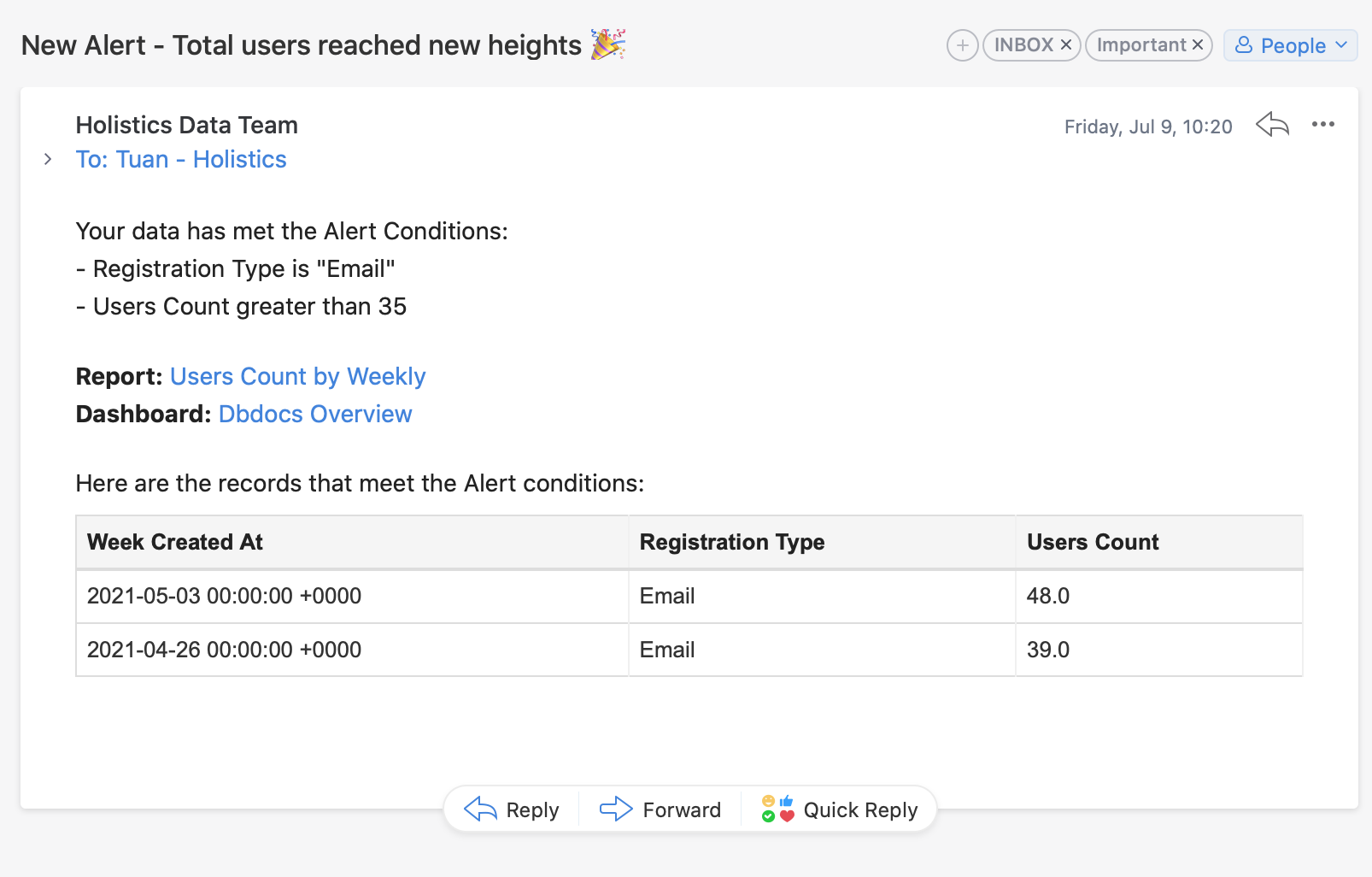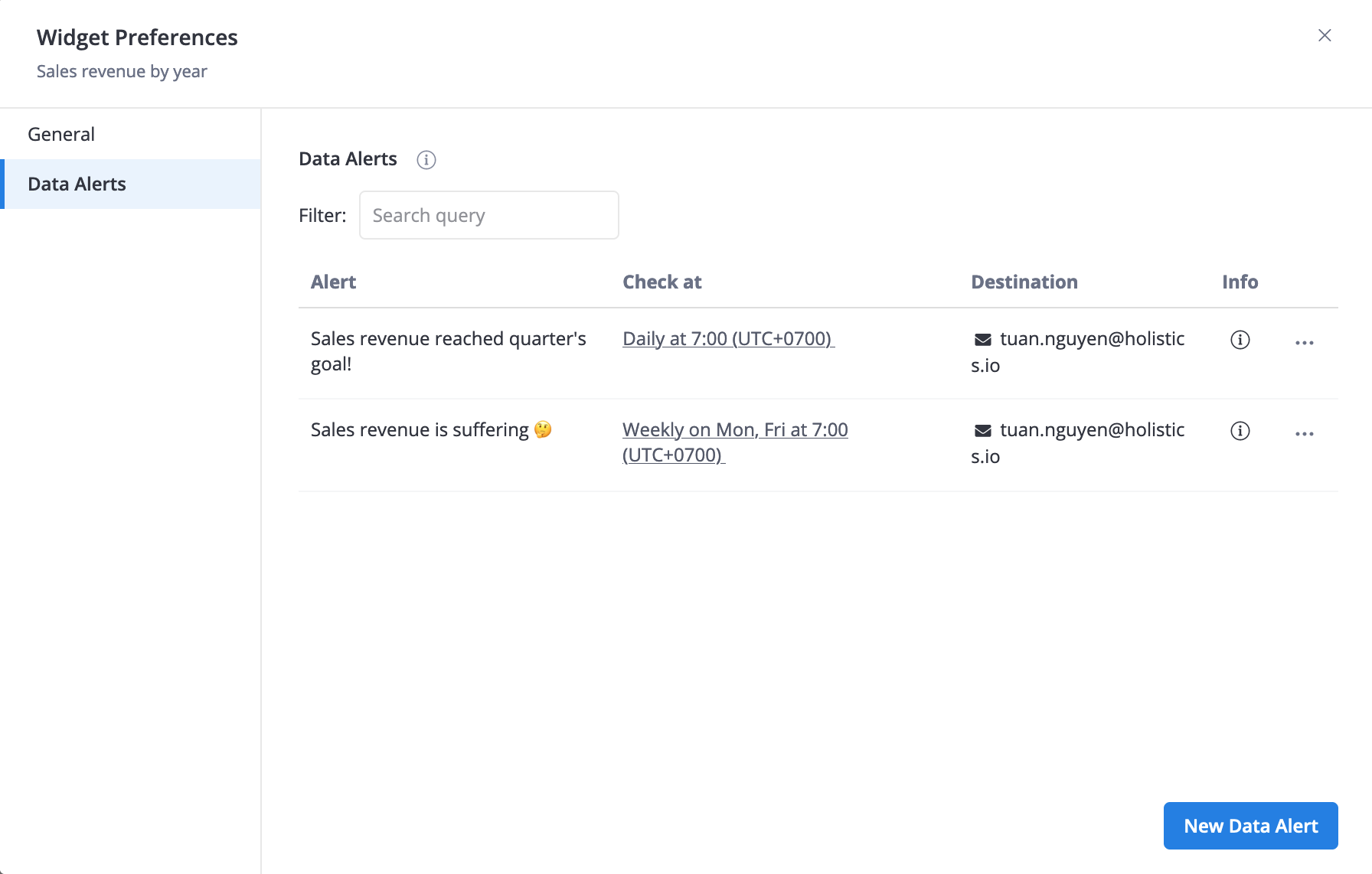Data Alerts
Introduction
Data Alerts allow users to receive automatic notifications when the data meets certain conditions, so they can make timely and strategic decisions for their business.

How to create an alert
To start creating an alert, select Data Alert from the menu icon of the report > click Create New Alert
Then fill in the following sections:
- Dashboard Filter (optional): The dashboard filters will be applied to the widget result first, before Holistics checks if the widget result meets the Alert Conditions below.
- Alert Conditions: Select the condition that you want your data to meet.
- Check Frequency: specify how often you want Holistics to check if your data meets the condition set in Alert Conditions.
- Alert destination and message: Select the channel you want to send the alert to (Email/Slack) and the message you want to include in the alert.
How to manage alerts
There are two ways to manage the alerts you have created.
To manage all the alerts of a report, click on the menu icon "..." in the top right of a report, select Data Alert.
At the Data Alert modal, you can view basic information of an alert: Title, Frequency, and Destination. Clicking on the menu icon "..." will give you 3 options: Edit, pause or delete an alert.

To manage all the alerts you have created, click on Tools > Data Alert. Here, you can filter out alerts whose channels are Email or Slack.

How Data Alert works
High level
Holistics Data Alert will be applied on each individual widget. Holistics will check the widget results at a user-specified frequency.
Then, if the results match a certain set of conditions, our system will send an alert to users via the selected channel.

Details
Holistics Data Alert comprises of three main components:
- Alert Conditions
- Alert Frequency
- Alert Destination
1. Alert Conditions
Alert Conditions are the criteria that the data must meet in order for the alert to be triggered. It contains a field (including Business Calculations fields), an operator, and a value. The fields that you can select are limited to fields used in the widgets settings.
If a field is removed from the widget settings, it will also be removed from the Alert Condition and displayed as "Invalid field". The alert will still run, but it will fail and will notify you via email.
Note: When the alert runs, it will scan the complete explore result, then send an alert if any record in the result matches the conditions
2. Alert Frequency
Alert Frequency specifies how often Holistics checks if the widget results meet the Alert Conditions.
For example, you have a widget for "App's Daily Active Users". You want to be notified when the number of daily users passes 1000. If you set the Alert Frequency to be Daily at 8:00 AM, Holistics will start checking the data at 8:00 AM every day to see if it is over 1000 or not.
3. Alert Destination
In Alert Condition, users can specify their preferred channel for receiving alerts. Holistics currently supports two channels: Slack and Email.
You can set up Webhooks as a destination for your data alerts to enable seamless integration with third-party applications and services. To learn more about using Webhooks for Data Alerts, please refer to this documentation.
Upcoming
- Support attachment files with format: PDF, PNG, CSV, Excel
FAQ
1. Which role can add or edit a Data Alert?
Users with Admin and Analyst role can add or edit any Data Alerts
2. Can I edit/remove the Data Alert created by another person?
Yes, if your role in Holistics is Admin or Analyst, you can do that.
3. When to use Dashboard filters?
It's best to use Dashboard filters when you want to limit the widget results before Holistics checks if that result meets the Alert condition.
Also, you might consider using Dashboard filters as an alternative to Alert Conditions when the field you want to set as Alert Conditions does not exist in the widget settings.
4.How many data alerts can I setup for a particular widget?
Actually, you can freely create data alerts in Holistics as many as possible. However, to normally run the alerts, you need to ensure the total object usage of your account does not exceed the usage quota of your pricing plan. For example:
- Your pricing plan provides you with total 200 objects
- You currently have total 5 reports. Each report is equal to 4 object. So you have used total 4x5 = 20 objects.
- Since 1 data alert = 5 objects, you can create maximum (200-20)/5 = 36 alerts.